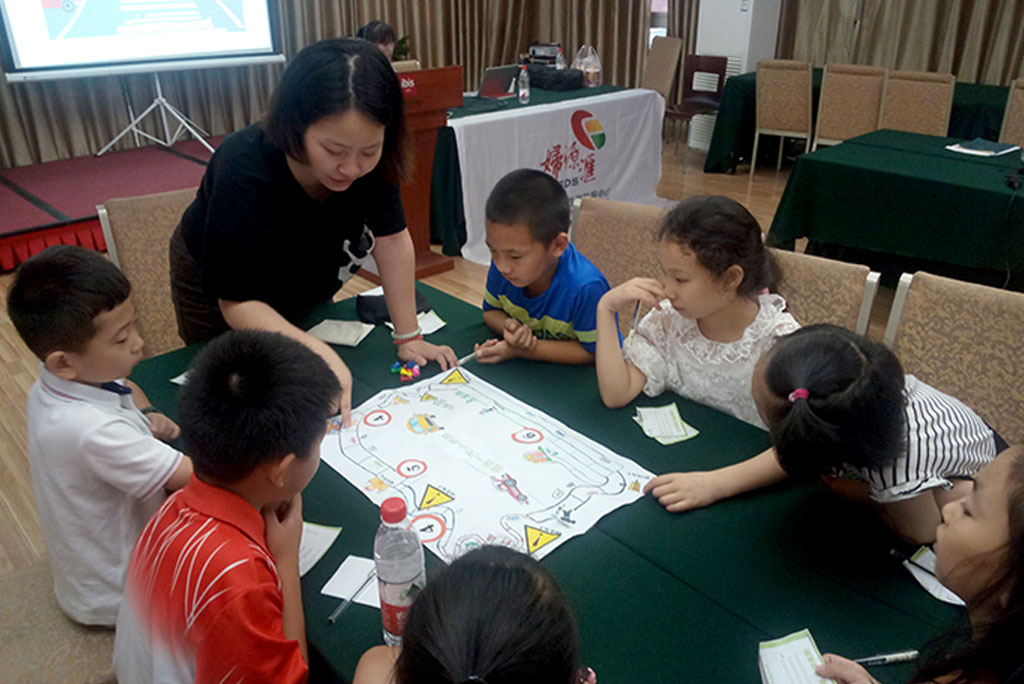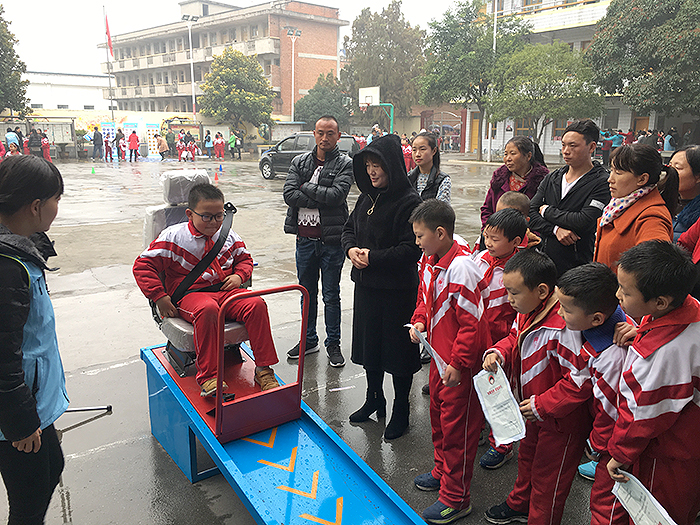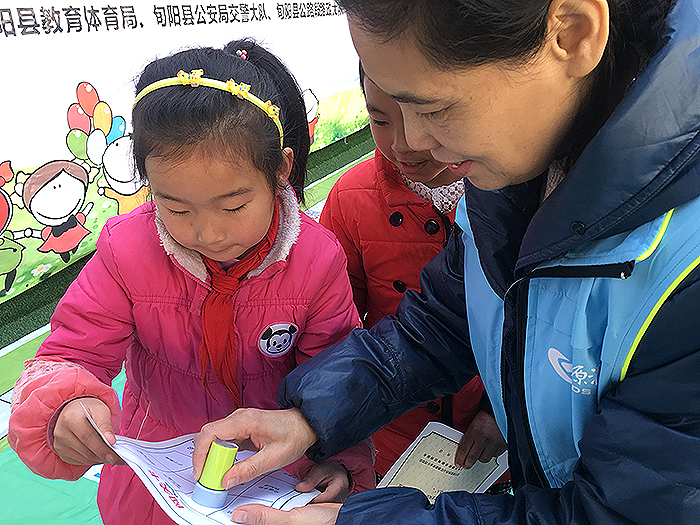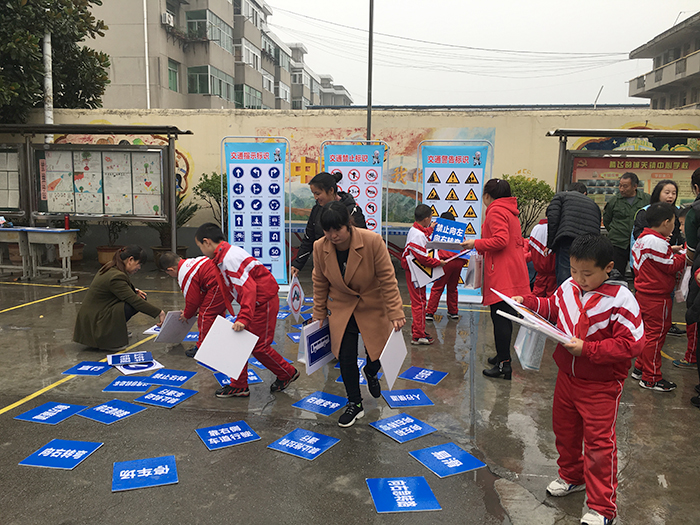East Asia Blog Series
Child-Centering Road Safety: Making Sure It Works for Girls and Boys
Rebecca A. Stapleton, Veronica Mendizabal Joffre, and Pinky Serafica 9 Oct 2020
They are seen, they are important road users, and their voice and agency can help make roads safer.
Overview
Infrastructure improvements are key to improving road safety for children. Yet, it does not start or end there. Road safety interventions need to go beyond infrastructure to assist government agencies to better manage and enforce road safety, and improve education, vehicles, emergency response, and post-crash care. Interventions are more effective when combined across the system to guide users to act safely.
From 2015–2020, the Asian Development Bank (ADB) supported a project in the People’s Republic of China (PRC) that made system-wide improvements to road safety, including infrastructure, institutional strengthening, and education interventions. The perspective of children—and the different views of girls and boys—were made explicit in the process so that the risks for this group of road users were understood and addressed. For this, child-centered and participatory methodologies were used in three primary schools and their communities along #102 Provincial Highway in Xunyang County, South Shaanxi.
Project information
46042-002: Shaanxi Mountain Road Safety Demonstration Project
Project snapshot
-
-
- Approval date: September 2015
- Completion date: December 2020
- Total cost: $400 million
- ADB loan: $200 million
- Executing agency: Shaanxi Provincial Department of Transport
- Financing: Asian Development Bank(link is external)
- Implementing agency: Shaanxi Provincial Finance Bureau, Shangnan County Traffic Bureau, Ankang City Traffic Bureau, Xunyang County Traffic Bureau, Hanbin District Traffic Bureau, Xunyang County Education Bureau, Xunyang County Traffic Police Brigade of Public Security Bureau
-
Challenges
Often, age and gender nuances in road safety interventions are not very visible. Baselines—if at all—do not go beyond segregating respondents as males and females. Too few inquiries are pursued on whether females have safer or riskier traveling practices, how they cope with harassments and assault on streets, or especially whether there are considerations for children.
The assumption is, when road safety programs are aimed at parents, that children are automatically protected. In Asia, children are often seen as extensions of parents, and their opinions are not taken seriously. Though kids are considered as road users, baselines and resulting interventions tend to target parents as the audience for road safety information to be passed on to children, as they are considered responsible for moving kids safely.
However, road traffic injuries are among the leading causes of death globally for children and young people, 5–29 years. The risk is higher for the youngest bracket, 5 to 9 years—the age when children start going to primary school and become active road users.
In addition to age, girls and boys exhibit different characteristics in their pedestrian behaviors. Boys are more likely to play on the side of the road and girls are more likely to walk two or three abreast. More male pedestrians than females are involved in road traffic crashes, especially in younger age groups. More effort is needed to determine and understand contextual risk factors for road traffic injuries and fatalities of children with implications for prevention.
Context
The Shaanxi Mountain Road Safety Demonstration Project aims to reduce road crash fatalities and serious injuries and provide efficient and safe all-weather accessibility in Shaanxi. The project covers Ankang City, including Xunyang County and Hanbin District, as well as Shangnan County in Shangluo City, and involves road upgrade and rehabilitation, incorporating major safety design enhancements.
In Ankang City, the transport bureau understood that rehabilitated trunk and rural roads can increase speeding, and unless these are designed with safety for all road users and not just cars, the most vulnerable road users—pedestrians and cyclists—will be at risk. Further, introducing new facilities, such as zebra crossings, are unlikely to be effective if users do not recognize them or know how to use them. For this reason, the bureau commissioned consultants from Shaanxi Gender Development Solution to improve user understanding of the project infrastructure changes, improve road safety knowledge, and influence behavior. This included dedicated interventions for children in three schools: Xiaohe Central Primary School, Chengguan Central Primary School, and Zhaowan Central Primary School.
Current road safety education usually follows a didactic approach, focusing on providing knowledge-based information to teachers, parents, and generally, any adult that could influence children’s way of thinking and behaving. This framework assumes that when knowledge is provided to these adults, it will be passed on to the kids who are then expected to remember and apply it now and in the future.
Adults are also assumed to model improved road safety behaviors after learning about them for children to emulate. In addition to modeling behavior, parents of younger children who have lower awareness of road safety must exercise primary responsibility to practice safety on their behalf.
Key Findings
Using mixed methods—survey, observation, and interviews of 1,361 children, parents, and teachers, the project looked not just at road safety knowledge from the point of view of adults but also from children’s behavior and the factors that influence why people act the way they do. They then went further to try to understand the different perceptions and behaviors of boys and girls around roads and address these through more accurate and successful interventions.
Below are the key findings among primary to middle school students that helped shape the road safety education interventions:
- Xunyang County is very mountainous characterized by steep, concrete, or asphalt roads.
- On average, most students attend nearby schools, with almost half living within 4 kilometers of school zones.
- About 76% of students are accompanied by parents to and from school; 24% of students go to school by themselves (percentage for girls is slightly higher than boys), 86% of whom walk. Others take the public bus (percentage of girls is slightly higher) while the rest ride bicycles and take the school bus (with the percentage of boys slightly higher in the last two modes).
- In group interviews, most students correctly answered more than 95% of questions on road safety behavior, with no difference between the answers of boys and girls. However:
- Students had low recognition of universal road traffic signs. Boys and girls showed less than 70% understanding of what red and green signals meant; only 52% recognized what yellow meant.
- Only 52% recognized pedestrian/zebra crossings.
- About 25% of parents also failed to recognize pedestrian/zebra crossing signs.
Survey responses showed that students had high awareness of road safety. However, in practice, their actual actions revealed otherwise, with many students displaying risky behaviors on the road.
Solutions
The ADB-supported Shaanxi Mountain Road Safety Demonstration Project adopted child-centered methodologies, developing age-appropriate curriculum for three levels of primary school students, including story books, games, simulation, and group learning activities. These are the key lessons.
 The project not only assessed children’s understanding of road safety but also studied their individual and collective road use habits. Photo credit: Shaanxi Gender Development Solution.
The project not only assessed children’s understanding of road safety but also studied their individual and collective road use habits. Photo credit: Shaanxi Gender Development Solution.
Although surveys indicated that there were no significant differences in the children’s knowledge and perceptions on road safety, their behaviors showed otherwise. Through observation, risky behaviors were identified that differed from survey responses. Designing for specific road users, such as children, requires information from their perspective and careful study of their individual and collective behaviors in road use.
Since 24% of students are unaccompanied by parents or caregivers and of these, 86% walk to and from school, it was crucial to identify how children use footpaths and zebra crossings. Boys and girls had different road use habits with associated risks.
When asked, 92% of boys and girls (statistically insignificant differences) said walking with linked arms along the road is risky. In practice, however, girls walked “hand-in-hand, shoulder-to-shoulder” with friends while boys played basketball along the side of the road. This risk is compounded by the fact that only 41% of parents recognized school zone warning signs.
Girls play and chase each other and cross the road to buy snacks from vendors often without paying attention to vehicles. About 45% of students (52% of girls) believe that it is safe to cross the road if they are close to a zebra crossing. A kid tries on a seat belt at a simulation camp. Photo credit: Shaanxi Gender Development Solution.
A kid tries on a seat belt at a simulation camp. Photo credit: Shaanxi Gender Development Solution.
Co-designing interventions with children improved their effectiveness and ensured that cognitive learning included experiences and interaction. Based on the behavioral findings, the following interventions were developed, tested with users, revised, scaled up, and implemented:
- Parent-child road safety camp with games designed to help families recognize risky behaviors. Games addressed topics, such as traffic signs, helmets, speed, safety regulations, traffic gestures, and being the “little passenger.” There was simulation learning for drunkenness and use of seatbelts.
- Community publicity where girls and boys created their own road safety messages and posted them in public places in schools and communities.
- Traffic simulation using moveable facilities and virtual reality equipment in a playground, including age-appropriate road scenarios. This included simulating observations of girls’ and boys’ behaviors, including crossing “roads” outside of zebra crossings, obeying traffic lights and signs, and walking along the “roadside” with simulated motorcycles and vehicles moving around.
 Girls get stamps on their pass cards. Photo credit: Shaanxi Gender Development Solution.
Girls get stamps on their pass cards. Photo credit: Shaanxi Gender Development Solution.
The intervention was unique in that it tried to identify specific uses of the road by girls and boys, which provided granular insights to design the interactive games and experiential learning tools. This sends a powerful message to girls and boys—that they are seen, that they are important road users, and this child-centered approach was a factor in increasing their engagement during the various activities.
 Children are tested on their understanding of transport signs through interactive activities. Photo credit: Shaanxi Gender Development Solution.
Children are tested on their understanding of transport signs through interactive activities. Photo credit: Shaanxi Gender Development Solution.
The goal of the interactive experiences was to transform traffic safety behavior, including through role models. This also provided an opportunity to remodel gender roles. The performance and role plays were designed to debunk gender stereotypes, such as a police officer always being male or a parent bringing the child to school is always the mother. Girls were asked to play police officers and boys to play fathers taking children to school. This is a small detail in the overall activity but with likely strong implications on children’s and even adults’ perceptions.
The process itself took a gender-sensitive approach. In the past, recruiting and training parent-volunteers for traffic safety activities focused on grandmothers and mothers due to belief that it is mainly their responsibility to take care of children and participate in school activities. For this project, fathers were actively engaged. Beyond their role in modeling road safety, this again has implications to transform gender roles and model more balanced sharing of childcare responsibilities.
Outcomes
- The process is now part of the institutional curriculum in three schools in Shaanxi province. The guidelines developed will serve to share the approach, the process, and the lessons learned, including the use of a gender perspective, with other schools within and outside the PRC.
- Multiple cohorts will be able to benefit from the experience as schoolteachers and traffic police were trained on the approach and participated actively in the design and delivery of the activities.
- Girls and boys participating in this interactive model of road safety training have been empowered through new knowledge and information but also as active users of the road. Furthermore, acknowledging the different behaviors and road uses of girls and boys has helped to address these in practice.
- One aspect of child-centering road safety is co-designing and testing behavior change interventions with children and adults around them. Using experiential learning and interaction improved and sustained the effectiveness of the interventions.
- Physical improvements to the school-zone road environment, including zebra crossings, footpaths, and traffic signs, were enhanced through games, school activities, and public communications, which ensured that the children and their parents understood and knew how to correctly use the improved facilities. This was further enhanced by child-friendly traffic signs drawn on flower beds along school streets and electricity poles.
- This experience will benefit a large number of children in Shaanxi province, as well as their parents, teachers, and road users in general, but a child-centered approach can benefit many more boys and girls by providing them information, tools, and self-awareness to become responsible road users.
References
ADB. People’s Republic of China: Shaanxi Mountain Road Safety Demonstration Project.
H. Wang et al. 2018. Gender Differences in Children’s Pedestrian Behaviors: Developmental Effects. Journal of Safety Research. December. 67. pp 127–133.
M. Onieva-Garcia et al. 2016. Gender and Age Differences in Components of Traffic-Related Pedestrian Death Rates: Exposure, Risk of Crash, and Fatality Rate. Injury Epidemiology. 9 August. 3(1). pp 20.
World Health Organization. 2020. Road Traffic Injuries: Key Facts. 7 February.
Authors

Rebecca A. Stapleton
Transport Specialist, East Asia Department, ADB

Veronica Mendizabal Joffre
Social Development Specialist, East Asia Regional Department, ADB

Pinky Serafica
Senior Communications Officer, Department of Communications, ADB
This blog is reproduced from Development Asia.


